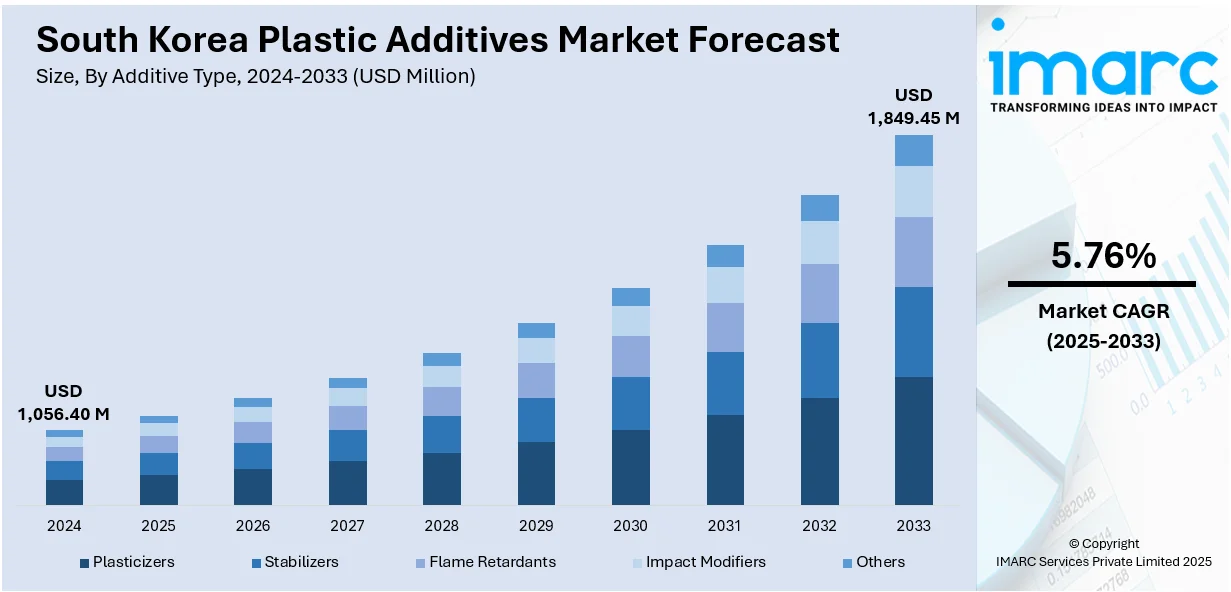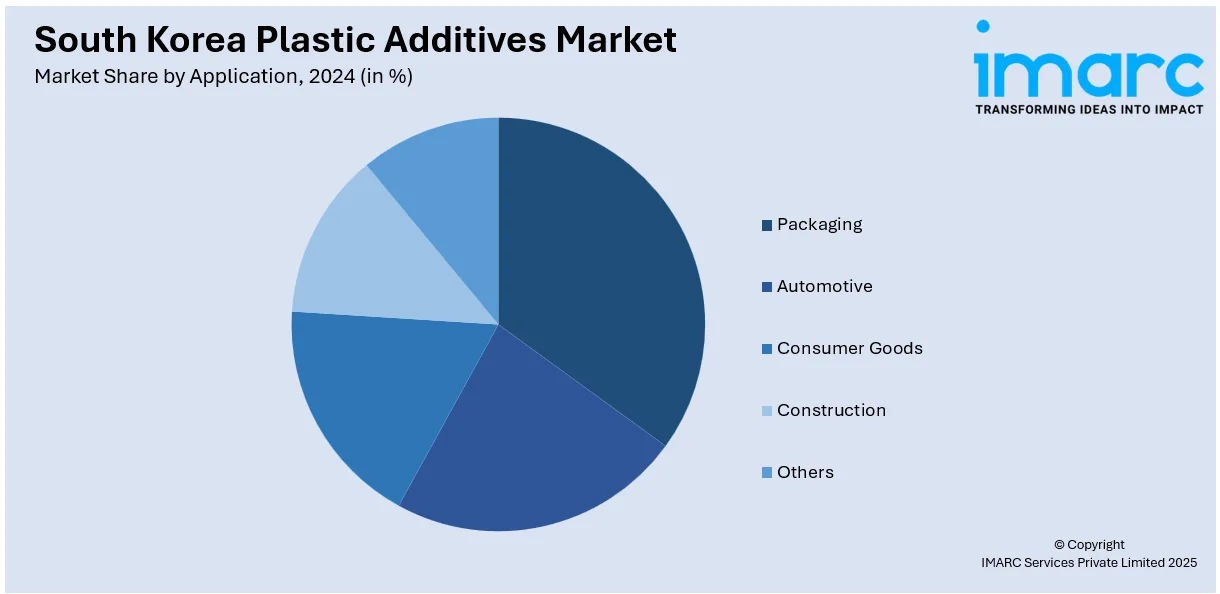
South Korea Plastic Additives Market Size, Share, Trends and Forecast by Additive Type, Plastic Type, Application, Function, and Region, 2025-2033
South Korea Plastic Additives Market Overview:
The South Korea plastic additives market size reached USD 1,056.40 Million in 2024. The market is projected to reach USD 1,849.45 Million by 2033, exhibiting a growth rate (CAGR) of 5.76% during 2025-2033. The market is transforming with increasing demand from the construction, automotive, and packaging industries. Increasing environmental concerns and regulatory requirements are prompting innovation in environmentally friendly and performance-enhancing additives. Increased demand for specialty additives enhancing plastic processing, appearance, and durability is also being observed in the market. Product segmentation and technology innovation remain the key drivers of competitive strategies. All these aspects put together create dynamic development in the South Korea plastic additives market share.
|
Report Attribute
|
Key Statistics
|
|---|---|
|
Base Year
|
2024 |
|
Forecast Years
|
2025-2033
|
|
Historical Years
|
2019-2024
|
| Market Size in 2024 | USD 1,056.40 Million |
| Market Forecast in 2033 | USD 1,849.45 Million |
| Market Growth Rate 2025-2033 | 5.76% |
South Korea Plastic Additives Market Trends:
Regulatory Support for Safer Industrial Materials
In February 2024, South Korea’s Ministry of Environment introduced updated chemical oversight policies to support safer use of additives in industrial materials. These changes emphasized streamlining approvals for lower-risk substances used in plastics manufacturing, including stabilizers, modifiers, and processing aids. By simplifying the compliance path for certain functional additives, producers are now better equipped to introduce materials that enhance heat resistance, flexibility, and strength in plastic-based applications. This momentum supports long-term development goals in sectors like automotive, construction, and manufacturing, where plastic performance plays a vital role. Materials with carefully selected additives now meet safety criteria more efficiently while enabling design flexibility. For developers and processors, regulatory clarity is opening doors to explore next-generation additive blends while staying aligned with safety standards. This evolution reflects how national oversight is playing a role in shaping the formulation and approval of performance-enhancing plastic ingredients. These policy adjustments signal a clear contribution to South Korea plastic additives market growth, where transparent regulation and industrial innovation are now moving forward in step.

To get more information on this market, Request Sample
Growing Adoption of Sustainable Additive Solutions
In August 2024, the Ministry of Environment announced reforms aimed at encouraging more sustainable approaches to plastic compound production. The updated guidelines enable faster review of additive ingredients derived from recycled content or post-industrial waste, reflecting a national push for circularity in material use. This change allows manufacturers to pursue greener alternatives in plastic formulations, particularly in packaging, consumer goods, and flexible film sectors. The ability to work with recycled-origin additives such as natural fillers, reprocessed stabilizers, or non-toxic plasticizers supports both performance optimization and environmental objectives. These innovations are reducing reliance on fossil-based ingredients while maintaining or enhancing mechanical strength and durability. The new framework also responds to growing public demand for transparency in sourcing and sustainability, pushing the industry to embrace lower-impact formulations. These evolving expectations are clearly influencing how and why additives are selected, from shelf-stable packaging to lightweight household plastics. Overall, this shift in regulatory and production practice is contributing directly to South Korea plastic additives market trends, where sustainability is now a central pillar of product development.
Advanced Materials for Electronics and Mobility
In March 2025, the Ministry of Trade, Industry and Energy released updated guidance supporting the development of advanced materials used in electronics and transportation. These updates emphasize the importance of heat-resistant and flame-retardant polymer components areas where plastic additives play a critical role. South Korea’s evolving mobility and electronics sectors are driving demand for specialty additives that improve mechanical strength, temperature stability, and conductivity in high-performance applications. From electric vehicles to 5G infrastructure, product designers are increasingly relying on tailored additive systems to meet demanding safety and reliability standards. New materials entering the market now include plastic blends made more durable and precise with thermal modifiers, insulative fillers, and stabilizers that maintain integrity under stress. These components are essential to the country’s growing push toward smarter, lighter, and safer technologies. As national innovation goals accelerate, plastic additives are proving fundamental to enabling technical advancements across sectors. These developments highlight trends, as specialty solutions shape the next generation of functional, high-performance plastics.
South Korea Plastic Additives Market Segmentation:
IMARC Group provides an analysis of the key trends in each segment of the market, along with forecasts at the country and regional levels for 2025-2033. Our report has categorized the market based on additive type, plastic type, application, and function.
Additive Type Insights:
- Plasticizers
- Stabilizers
- Flame Retardants
- Impact Modifiers
- Others
The report has provided a detailed breakup and analysis of the market based on the additive type. This includes plasticizers, stabilizers, flame retardants, impact modifiers, and others.
Plastic Type Insights:
- Commodity Plastic
- Engineering Plastic
- High Performance Plastic
A detailed breakup and analysis of the market based on the plastic type have also been provided in the report. This includes commodity plastic, engineering plastic, and high performance plastic.
Application Insights:

- Packaging
- Automotive
- Consumer Goods
- Construction
- Others
The report has provided a detailed breakup and analysis of the market based on the application. This includes packaging, automotive, consumer goods, construction, and others.
Function Insights:
- Property Modifiers
- Property Stabilizers
- Property Extenders
- Processing Aids
A detailed breakup and analysis of the market based on the function have also been provided in the report. This includes property modifiers, property stabilizers, property extenders, and processing aids.
Regional Insights:
- Seoul Capital Area
- Yeongnam (Southeastern Region)
- Honam (Southwestern Region)
- Hoseo (Central Region)
- Others
The report has also provided a comprehensive analysis of all the major regional markets, which include the Seoul Capital Area, Yeongnam (Southeastern Region), Honam (Southwestern Region), Hoseo (Central Region), and others.
Competitive Landscape:
The market research report has also provided a comprehensive analysis of the competitive landscape. Competitive analysis such as market structure, key player positioning, top winning strategies, competitive dashboard, and company evaluation quadrant has been covered in the report. Also, detailed profiles of all major companies have been provided.
South Korea Plastic Additives Market News:
- February 2025: SK Chemicals has unveiled plans to establish a Recycle Innovation Center (RIC) at its Ulsan facility in South Korea. This will be the country’s first depolymerisation based recycling hub, transforming low-grade waste plastics, such as films, textiles, and automotive parts into recyclable raw materials like r-BHET. The integrated centre will combine research, demonstration, and production under one roof, enabling rapid development of circular solutions tailored to local industries. Expected to begin operations in 2026, the RIC reinforces SK Chemicals’ leadership in South Korea’s sustainable plastics landscape.
South Korea Plastic Additives Market Report Coverage:
| Report Features | Details |
|---|---|
| Base Year of the Analysis | 2024 |
| Historical Period | 2019-2024 |
| Forecast Period | 2025-2033 |
| Units | Million USD |
| Scope of the Report |
Exploration of Historical Trends and Market Outlook, Industry Catalysts and Challenges, Segment-Wise Historical and Future Market Assessment:
|
| Additive Types Covered | Plasticizers, Stabilizers, Flame Retardants, Impact Modifiers, Others |
| Plastic Types Covered | Commodity Plastic, Engineering Plastic, High Performance Plastic |
| Applications Covered | Packaging, Automotive, Consumer Goods, Construction, Others |
| Functions Covered | Property Modifiers, Property Stabilizers, Property Extenders, Processing Aids |
| Regions Covered | Seoul Capital Area, Yeongnam (Southeastern Region), Honam (Southwestern Region), Hoseo (Central Region), Others |
| Customization Scope | 10% Free Customization |
| Post-Sale Analyst Support | 10-12 Weeks |
| Delivery Format | PDF and Excel through Email (We can also provide the editable version of the report in PPT/Word format on special request) |
Key Questions Answered in This Report:
- How has the South Korea plastic additives market performed so far and how will it perform in the coming years?
- What is the breakup of the South Korea plastic additives market on the basis of additive type?
- What is the breakup of the South Korea plastic additives market on the basis of plastic type?
- What is the breakup of the South Korea plastic additives market on the basis of application?
- What is the breakup of the South Korea plastic additives market on the basis of function?
- What is the breakup of the South Korea plastic additives market on the basis of region?
- What are the various stages in the value chain of the South Korea plastic additives market?
- What are the key driving factors and challenges in the South Korea plastic additives market?
- What is the structure of the South Korea plastic additives market and who are the key players?
- What is the degree of competition in the South Korea plastic additives market?
Key Benefits for Stakeholders:
- IMARC’s industry report offers a comprehensive quantitative analysis of various market segments, historical and current market trends, market forecasts, and dynamics of the South Korea plastic additives market from 2019-2033.
- The research report provides the latest information on the market drivers, challenges, and opportunities in the South Korea plastic additives market.
- Porter's five forces analysis assist stakeholders in assessing the impact of new entrants, competitive rivalry, supplier power, buyer power, and the threat of substitution. It helps stakeholders to analyze the level of competition within the South Korea plastic additives industry and its attractiveness.
- Competitive landscape allows stakeholders to understand their competitive environment and provides an insight into the current positions of key players in the market.
Need more help?
- Speak to our experienced analysts for insights on the current market scenarios.
- Include additional segments and countries to customize the report as per your requirement.
- Gain an unparalleled competitive advantage in your domain by understanding how to utilize the report and positively impacting your operations and revenue.
- For further assistance, please connect with our analysts.
 Request Customization
Request Customization
 Speak to an Analyst
Speak to an Analyst
 Request Brochure
Request Brochure
 Inquire Before Buying
Inquire Before Buying




.webp)




.webp)












